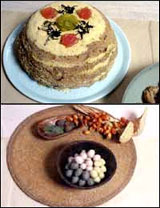|
|
|

Cholpyon Rice Cakes
Beautiful and Tasty Too!
 tok, rice cake made with sesame oil or yot(wheat gluten), is a Korean delicacy. It was a rare treat in old times, when ttok was eaten only on holidays. There are several kinds of rice cakes. The most popular is shiruttok. The first step in making it is to grind rice to powder in mattol, or handmill. Then that steamed to make shiruttok. The smell of steaming shiruttok delights Koreans. Another kind of ttok has its own distinctive sound - the noise of mallets !
tok, rice cake made with sesame oil or yot(wheat gluten), is a Korean delicacy. It was a rare treat in old times, when ttok was eaten only on holidays. There are several kinds of rice cakes. The most popular is shiruttok. The first step in making it is to grind rice to powder in mattol, or handmill. Then that steamed to make shiruttok. The smell of steaming shiruttok delights Koreans. Another kind of ttok has its own distinctive sound - the noise of mallets !
This ttok is made by first steaming rice powder or cooking rice, then putting the cooked rice on a flat board and hitting with a mallet. The "tok-tok-tok" of ttok being made was a welcome sound in Korean villages. Even now, Koreans associate the pounding noise of mallets with happy holiday meals.
 The most attractive kind of Korean rice cake is cholpyon. After pounding with mallets, rice is made into cakes with decorative patterns impressed on them.
The patterns are made by pressing cholpyon in a wooden pattern mold called a ttokssal. The rice cake is coated with sesame oil to keep it from sticking to the mold. During the Choson Dynasty, the ttokssal was especially important to Korea's ruling class, or yangban. There was a custom that government officials and their families would make cholpyon and share them with neighbors every January according to the lunar calendar. On these occasions, the ttokssal got a workout !
The most attractive kind of Korean rice cake is cholpyon. After pounding with mallets, rice is made into cakes with decorative patterns impressed on them.
The patterns are made by pressing cholpyon in a wooden pattern mold called a ttokssal. The rice cake is coated with sesame oil to keep it from sticking to the mold. During the Choson Dynasty, the ttokssal was especially important to Korea's ruling class, or yangban. There was a custom that government officials and their families would make cholpyon and share them with neighbors every January according to the lunar calendar. On these occasions, the ttokssal got a workout !
The ttokssal usually is wooden but may be made of celadon or porcelain instead. Specific materials are used for certain patterns. Circular patterns are produced by porcelain and ceramics, which are easy to mold into ttokssal. Square patterns are carved in wood, which is boiled in salt water and then dried in the sun to ensure a smooth texture and prevent decay. Cholpyon in Buddhist temples was impressed with the Buddhist emblem of a lotus flower. Other patterns, such as a pair of bats, represented wishes for good luck.
english.tour2korea.com
|
|
|

 The most attractive kind of Korean rice cake is cholpyon. After pounding with mallets, rice is made into cakes with decorative patterns impressed on them.
The patterns are made by pressing cholpyon in a wooden pattern mold called a ttokssal. The rice cake is coated with sesame oil to keep it from sticking to the mold. During the Choson Dynasty, the ttokssal was especially important to Korea's ruling class, or yangban. There was a custom that government officials and their families would make cholpyon and share them with neighbors every January according to the lunar calendar. On these occasions, the ttokssal got a workout !
The most attractive kind of Korean rice cake is cholpyon. After pounding with mallets, rice is made into cakes with decorative patterns impressed on them.
The patterns are made by pressing cholpyon in a wooden pattern mold called a ttokssal. The rice cake is coated with sesame oil to keep it from sticking to the mold. During the Choson Dynasty, the ttokssal was especially important to Korea's ruling class, or yangban. There was a custom that government officials and their families would make cholpyon and share them with neighbors every January according to the lunar calendar. On these occasions, the ttokssal got a workout !